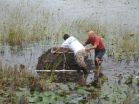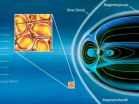(Press-News.org) LA JOLLA, CA – January 8, 2013 - Chemists at The Scripps Research Institute (TSRI) have found an easier way to perform one of the most fundamental tasks in molecular biology. Their new method allows scientists to add a marker to certain cells, so that these cells may be easily located and/or selected out from a larger cell population.
The technique, which is described in a recent issue of the chemistry journal Angewandte Chemie International Edition, makes use of the tight binding of two proteins that are cheaply obtainable but are not found in human or other mammalian cells. As such, it has advantages over existing cell-marking techniques.
"This new technique is cheap, easy and sensitive," said TSRI Institute Professor Richard A. Lerner, who is the senior author of the new report. "The method should be useful in a variety of applications that require separating out certain types of cells."
Looking for a Better Way
The best-known cell marker in use today is GFP (green fluorescent protein), a jellyfish protein that emits a distinctive green light when illuminated by certain other light wavelengths. When scientists want to add a new gene to cells, for example to produce a therapeutic protein, they often construct a genetic sequence that also includes the GFP gene. Thus the cells that successfully produce the new protein will also produce GFP, whose fluorescence allows these cells to be identified and even sorted out from a larger population.
But fluorescence-based cell sorting is relatively expensive and cumbersome. Alternative cell-marking techniques use marker molecules to which antibodies or metals will bind tightly, but these are apt to have unwanted side effects on the cells that they mark. Lerner's team, led by first author Yingjie Peng, a postdoctoral fellow, set out to invent a better method.
The new method exploits a special property of chitinase enzymes, which evolved to break down chitin—a tough, sugar-derived material found, for example, in crab shells, squid beaks and the cell walls of fungi. In addition to a main chitin-breaking domain, chitinases have another active structure, a "chitin binding domain" (ChBD). "It makes a super-strong bond with chitin," said Peng. In recent years, scientists have begun to use this high-affinity binding of ChBD and chitin as a marker system, typically for selecting ChBD-tagged proteins in a lab dish. The new method uses ChBD to mark and select cells.
A Powerful Tool
In the basic technique, a new gene can be added to cells within a larger DNA vector that also includes the genetic sequences for ChBD and GFP. The ChBD molecule will be produced in such a way that it ends up being held on the outer surface of its host cell's plasma membrane—and the GFP molecule will sit just inside the membrane. The GFP serves as a visual beacon, while the ChBD serves as a handy gripping point for cell selection.
After exposing a culture of test cells to this experimental ChBD-containing vector, the scientists was able to see, via the GFP tags, which cells were expressing them, and was able to select them out easily, with high sensitivity, using magnetic beads coated with chitin. "This is a relatively easy benchtop method," Peng said. Importantly, these selected cells could produce progeny cells that seemed normal and healthy.
Because the ChBD marker, in the vector, is produced in a way that anchors it to a cell's membrane, it also can serve as a powerful tool for selecting just the membrane fraction of a sample of cellular material. Peng and his colleagues demonstrated this using chitin beads to quickly isolate a pure fraction of membrane material from ChBD-marked test cells.
Cellulase enzymes, which break down the ubiquitous plant compound cellulose, also have a high-affinity cellulase-binding domain, which can be employed in the same way as the ChBD.
The scientists expect that the new cell-marking method will help to streamline another major molecular biology technique, which was pioneered by the Lerner laboratory in parallel with the group of Sir Gregory Winter at the Laboratory of Molecular Biology in Britain. This technique allows scientists to produce very large and diverse libraries of antibody arms, and to sift through them, or "pan"—as gold miners pan for nuggets—for those that might be of use, for example in therapies. ChBD-based markers should be useful in boosting the efficiency of this panning process, said Peng.
The Lerner laboratory is also investigating the potential use of ChBD-based cell marking in living animals, for example to track the fates of selected cell types throughout an animal's lifespan.
INFORMATION:
Those interested in using the new technology are invited to contact TSRI's Office of Technology Development, at (858) 784-8140 or through the department's webpage at http://www.scripps.edu/research/technology/contactus.html.
Other contributors to the study, "Engineering Cell Surfaces for Orthogonal Selectability," were Teresa M. Jones and Diana I. Ruiz of the TSRI Department of Chemistry, and Dae Hee Kim of the Scripps Korea Antibody Institute. For more information on the paper, see http://onlinelibrary.wiley.com/doi/10.1002/anie.201201844/abstract
The research was supported by a grant from Scripps Korea Antibody Institute.
END
Foreign invaders such as pythons and lionfish are not the only threats to Florida's natural habitat. The native Carolina Willow is also starting to strangle portions of the St. Johns River.
Biologists at the University of Central Florida recently completed a study that shows this slender tree once used by Native Americans for medicinal purposes, may be thriving because of water-management projects initiated in the 1950s. Canals were built to control runoff and provide water for agriculture. The unintended consequence -- stable water levels -- allowed Carolina Willow ...
New York children participating in a federal nutrition program had healthier eating behaviors and lower rates of obesity two years after improvements to the program were undertaken, according to a study published online today in Obesity, the official journal of the Obesity Society.
In 2009 all 50 states rolled out sweeping changes to the menu of foods available through the Special Supplemental Nutrition Program for Women, Infants, and Children, or WIC, which reaches nearly half of all infants born in the United States. New York was the first state in the nation to roll ...
A new American Chemical Society (ACS) video provides a behind-the-scenes-look at the DayGlo Color Corp. factory, producer of the fluorescent paints that light up traffic cones, black light posters, hula-hoops and other products. The video, the latest episode of the award-winning Bytesize Science series from the world's largest scientific society, is at www.BytesizeScience.com.
Inside DayGlo opens with a brief history of the company, which has been designated as an ACS National Historic Chemical Landmark, and continues with an in-depth look inside its main production ...
With the first explosions of atomic bombs, the world became witness to one of the most important and consequential principles in physics: Energy and mass, fundamentally speaking, are the same thing and can, in fact, be converted into each other.
This was first demonstrated by Albert Einstein's Theory of Special Relativity and famously expressed in his iconic equation, E=mc2, where E stands for energy, m for mass and c for the speed of light (squared).
Although physicists have since validated Einstein's equation in countless experiments and calculations, and many technologies ...
VIDEO:
This is a computer simulation of one octant of a core collapse supernova, using SNSPH.
Click here for more information.
Two University of Texas at Arlington researchers want to bridge the gap between what is known about exploding stars and the remnants left behind thousands of years later. So they're trying something new – using SNSPH, a complex computer code developed at Los Alamos National Laboratory.
On Tuesday, Carola I. Ellinger, a post-doctoral researcher at ...
By taking a "bottom-up" approach, researchers at the University of Illinois at Urbana-Champaign have observed for the first time that "size does matter" in regards "pyroelectricity"—the current/voltage developed in response to temperature fluctuations that enables technologies such as infrared sensors, night-vision, and energy conversion units, to name a few.
"Controlling and manipulating heat for applications such as waste heat energy harvesting, integrated cooling technologies, electron emission, and related functions is an exciting field of study today," explained ...
HERSHEY, Pa. -- While the number of overweight and obese Americans has increased, the amount of weight counseling offered by primary care physicians has decreased -- especially for patients with high blood pressure and diabetes -- according to Penn State College of Medicine researchers.
More than 145 million adult Americans are overweight or obese.
Researchers analyzed data from the National Ambulatory Medical Care Survey for the years 1995-1996 and 2007-2008. This national survey collects information about the provision and use of outpatient medical care services in ...
Our Milky Way is a spiral galaxy - a pinwheel-shaped collection of stars, gas and dust. It has a central bar and two major spiral arms that wrap around its disk. Since we view the Milky Way from the inside, its exact structure is difficult to determine.
Astronomers have identified a new structure in the Milky Way: a long tendril of dust and gas that they are calling a "bone."
"This is the first time we've seen such a delicate piece of the galactic skeleton," says lead author Alyssa Goodman of the Harvard-Smithsonian Center for Astrophysics (CfA). Goodman presented the ...
ROCHESTER, Minn. -- A combination of the drugs pazopanib and paclitaxel shows promise in slowing anaplastic thyroid cancer (ATC), according to a Mayo Clinic-led study published in the journal Science Translational Medicine. The two drugs together resulted in greater anti-cancer activity in ATC than either drug alone, says lead researcher Keith Bible, M.D., Ph.D., a Mayo Clinic oncologist.
Anaplastic thyroid cancer is a rare but devastating form of thyroid cancer that typically strikes men and women in their 60s and 70s. It is very aggressive, with a median survival ...
The sun ejects a continuous flow of electrically charged particles and magnetic fields in the form of the solar wind -- and this wind is hotter than it should be. A new study of data obtained by European Space Agency's Cluster spacecraft may help explain the mystery.
The solar wind is made of an electrically-charged gas called plasma. One theory about the wind's puzzling high temperatures is that irregularities in the flow of charged particles and magnetic fields in the plasma create turbulence, which, in turn, dissipates and adds heat to its surroundings. Using two separate ...


